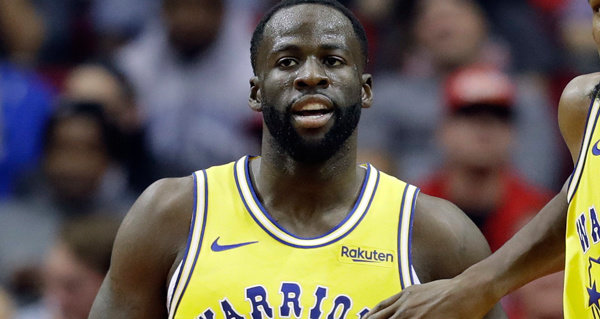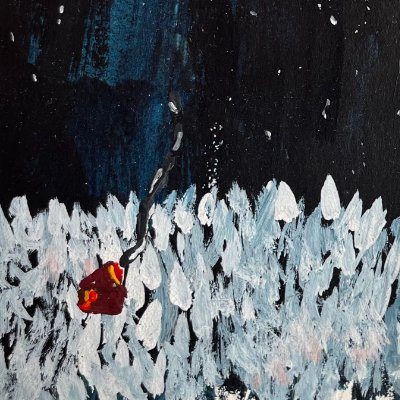Theory: there’s an inverse relationship between each Golden State star’s individual talent and the extent to which they seem to exist within the larger structure of the team. Kevin Durant is the second-best player of his generation, showed up late to the party, and is basically his own entity, like a famous actor self-billing it for five minutes in a movie otherwise populated by other famous actors playing characters. Steph Curry has been around since the beginning, and he embodies the Warriors’ ethos by being able to make dropping 30-plus points look unselfish, but he also has the ability to just start bombing them in from the parking lot, a feat that obliterates both the opposing defense and the need for teammates. Klay Thompson could probably put up impressive numbers shouldering the scoring load for a lesser squad, but he is, both temperamentally and due to his deep yet narrow skill set, an ideal sidekick or third banana. He’s right where he belongs.
What would Draymond Green be if he played for the Hornets? Of course he wouldn’t lose his ability overnight. He would still be one of the most intelligent, versatile defenders in the league. He would still be a sharp passer. We might appreciate certain dimensions of his game more than we do now, just by dint of him having the ball in his hands more. But Draymond does feel, more than any of his All-NBA caliber teammates, like a construction, a not-quite-great player so completely in his element that he achieves much more than he could anywhere else.
This isn’t to say Draymond is inessential, or that the Warriors have somehow done him a favor over these past five years. In the pre-Durant era, he was—taking Klay and Steph shooting the lights nearly every night as a given—the guy who put Golden State over the top. The backcourt was a handful on its own, and then, man alive, opponents had to contend with a playmaking center who could defend every position on the floor. It’s in the eye of the beholder whether it’s telling or misleading that when the Warriors lost to the Cavs in the 2016 Finals, Draymond missed Game 5 and was awesome in Game 7 as Klay and Steph struggled, but he inarguably mattered, both in terms of his basketball ability and the barfighting edge he provided, which kept the Warriors swaggering even in the tensest moments. If it’s possible to be the heart and soul of a team while also being its third-best player, Draymond was it. At any rate, he was definitely the lungs.
These days he seems to be made mostly of wind. Calling him an offensive liability is a stretch, because he can still find cutters and shooters, but it’s been well-documented—the entire league has noticed—that his shot is busted. His scoring numbers over 21 games: 7.1 PPG, 40.7 percent from the field, and 22.4 percent from three. Though he’s never been a prolific free throw shooter, he hardly gets to line at all anymore, an indication that nobody’s guarding him closely. This is Marcus Smart type stuff, the kind of play you have to justify. Well, he is an excellent defender. Well, he does keep everybody energized when he’s out there. The thing is, until this season, Draymond Green wasn’t a player who needed to be argued for. You watched the Warriors and you understood his value. He still has a purpose, but it’s more muddled than ever before. And when he’s, say, publicly feuding with Kevin Durant, you wonder, if only for a moment, if he’s worth the trouble.
This is the ultimate consequence of Durant’s Golden State switch. Stacked and successful as they are, the Warriors don’t need Draymond operating at peak capacity anymore, and perhaps the light malaise that has affected the entire roster over the past couple seasons is affecting Draymond more acutely than his star teammates. He relies upon a certain anger and malice to play all the way up to his potential, and there simply hasn’t been a lot to rile him up lately. This might explain his cruelty toward Durant. He’s searching for something to get upset about, lashing out in unhelpful ways.
It’s tempting, especially in the wake of the Warriors getting hit over the head with Jack Nicholson’s folding chair on Christmas, to posit this as some big problem, but it’s really not. Draymond’s contract isn’t up until 2020, and it’s going to take much more than a moderate decline out of him—an ill-timed Durant or Curry injury, some league-altering midseason trade—to knock them off their championship course. What’s in danger, or maybe just in flux, is the team’s identity. (Yes, these are the stakes Golden State mess around with. It’s not whether they’ll win, but how.) Draymond has been, since the franchise’s meteoric ascent began under Steve Kerr, the Warriors-est Warrior, at the center of the squad’s collective being. As he continues to struggle and drifts further toward the margins of what the team accomplishes on the court, they become less like themselves. They don’t fall apart, exactly, but something is lost.



